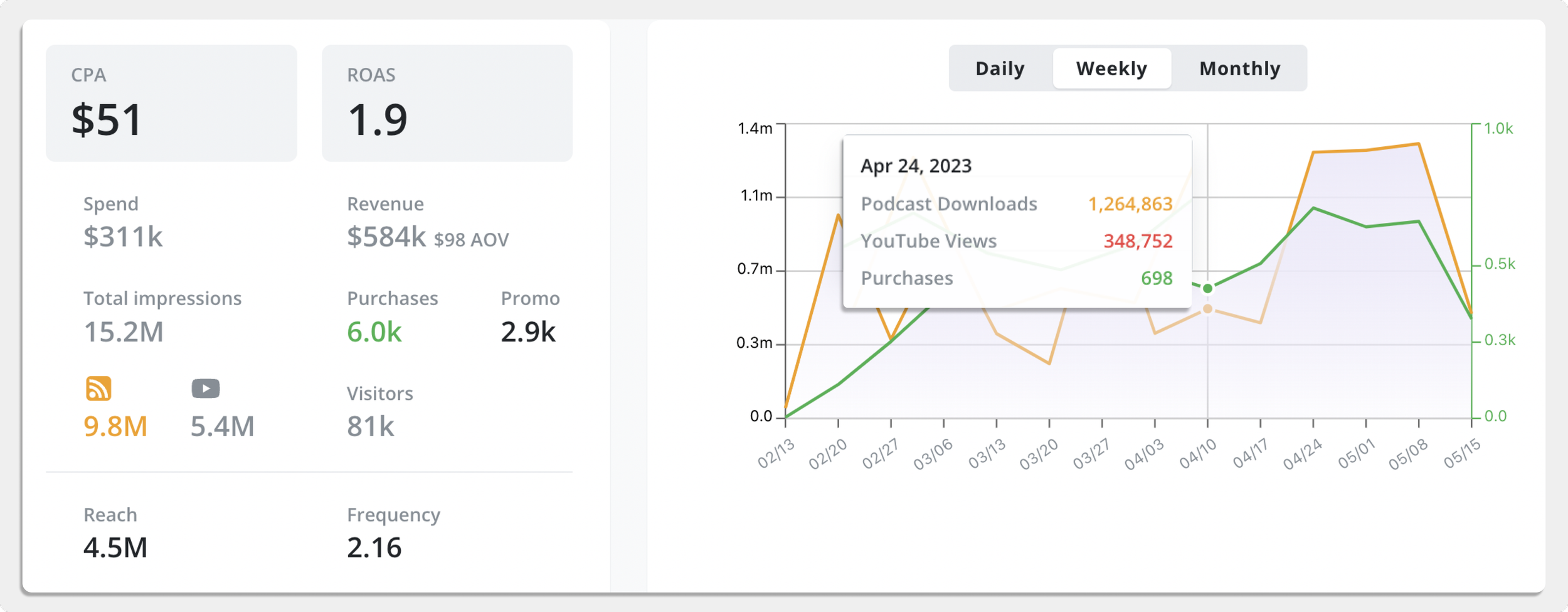Introducing - Simulcast Attribution
Podscribe Launches YouTube Conversion Modeling
Podscribe is proud to announce the launch of a highly anticipated feature: YouTube Conversion Modeling!
For the first time ever, view your simulcast campaign performance alongside your podcast campaign performance on one unified dashboard. See your pixel-based performance apples to apples.
For brands that historically could not advertise on YouTube due to lack of attribution, this may unlock previously blocked dollars.
To accomplish this, Podscribe applies the audio conversion rate to YouTube views for the corresponding ad and episode.
Understanding the Need for Simulcast Reporting
Simulcasting (posting podcasts to both the RSS feed and YouTube) has gained popularity in recent years. It’s a no-brainer for publishers looking to grow their audience.
However, this creates reporting and attribution challenges. Publishers and advertisers must now look at different platforms to understand the most basic of questions - how many people listened to (or watched) the episode?
Podscribe earlier this year announced a solution to let publishers and advertisers easily see on one dashboard how many impressions an ad got across both RSS and YouTube. Advertisers easily can see when their simulcast campaigns under (or over) deliver, while publishers can at a glance know their exact audience size for every episode and show.
However, the performance of those views from YouTube still remained a question. In podcasting, attribution can be performed by matching listener IPs to purchaser IPs (attribution 101). On YouTube though, this is impossible because Google does not let vendors have access to the viewer IPs.
This has forced simulcast advertisers into a myriad of contortions, such as relying on pixel data for the podcast side, and post-purchase survey or promo data for the YouTube side. Publishers sell the audio & video together, but only the audio side has supported pixel-based attribution.
The Simple Solution
To streamline simulcasting, take the conversion rate an ad gets on a podcast episode, and apply that conversion rate to the identical episode posted on YouTube with the identical ad.
Many consider using the audio conversation rate to video as conservative, since downloads & views have different qualities. Given more data, we may consider adjusting to perhaps use a 1.25x the audio conversion rate on YouTube.
For now though, this solution lets marketers view on one, real-time automated dashboard their simulcast performance just as they’d view any ordinary audio campaign.
Features
100% Automated
One Unified, Real-time Dashboard
Independent, 3rd-Party
IAB-certified
Available via API, s3, Google Sheet Sync
Networks: Sell More, Make More
Sell to more brands
When brands say they can’t buy your simulcast shows due to lack of attribution, you now know what to say
Fewer cancellations
Are buyers giving your simulcast views the credit they deserve? Pixel based dashboards often give don’t even report YouTube views delivered, let alone their performance.
Save time
Instantly see how your simulcast campaigns are pacing. See combined audience sizes across platforms.
Advertisers: Automate everything
One real-time dashboard with all you need
Waste no more time on manual time-consuming solutions.
Lack of Attribution Blocking you from Simulcasts?
Stop missing out on YouTube inventory from the same audiences and shows that are working on podcasts.
Next Steps
This is a simple but not perfect solution. We plan to improve by releasing in the next few weeks more sophisticated YouTube modeling based on post-purchase survey data.
We are pulling in Fairing data first - reach out to get started as a beta tester now!
Got other ideas for how we can improve? Let us know!






